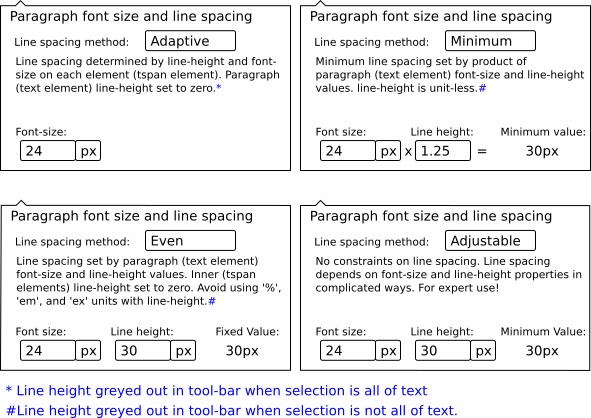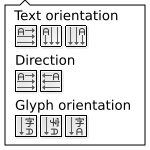Text toolbar rewrite
Jump to navigation
Jump to search
The printable version is no longer supported and may have rendering errors. Please update your browser bookmarks and please use the default browser print function instead.
The text toolbar has become a monstrosity. This page is for discussing how to rework the toolbar into something more usable.
Issues
- Text toolbar shows too many options.
- Line height control is confusing.
Ideas
- Utilize "hamburger" menus to hide less used options:
- Either: Put all "overflow" options in one big menu.
- Or: Put options in to several menus
- Glyph tweaking (rotating, etc.). (Maybe not convenient.)
- Writing modes (vertical/horzontal, right-to-left, etc.). (These are usually set once and then forgotten.)
- Move some of the options to mini-dialogs.
- This could be useful, for example, where you want the controls readily available (like the glyph positioning ones).
- Mini-dialogs allow more text to explain what is happening.
- Should work well when we move to the tabbed dialog framework.
- Set a default line spacing option, require user to use hamburger menu (or mini-dialog) to change option.
- Which option should be the default?
Mock-ups
Line spacing
Line spacing is complicated:
- The minimum line-height is set by the 'font-size' and 'line-height' properties on the text element.
- 'line-height' and/or 'font-size' can be set on any tspan element.
- 'line-height' % values and pure numeric values have different meanings:
- %: 'line-height' computed values is fixed by element where 'line-height' property is set. One set, computed value is inherited by all child elements.
- Number: 'line-height' computed value is determined anew for each child element using the child-elements font-size and line-height values (which can be inherited).
Inkscape has four options for determining 'line-height' behavior. Three of the options enforce certain rules:
- Adaptive: 'line-height' is set to zero on text element, this allows computed line-height to be any value in child elements.
- Minimum: 'line-height' values is set to some non-zero value on text element. This sets a minimum line-height computed value. Line spacing can be larger but not smaller.
- Even: 'line-height' value is set on text element. line-height computed value is fixed regardless of font-size in child elements (provided line-height unit is not '%', 'em', or 'ex').
- Adjustable: Inkscape enforces no restrictions on 'line-height' and 'font-size' values. The user must fully understand how 'line-height' and 'font-size' interact with inheritance.
This proposal returns font-size and line-height to follow all other properties:
- If there is no selection (just a blinking cursor), font-size and line-height entries apply to entire text.
- If there is a selection (some text high-lighted), font-size and line-height entries apply to selection.
The toolbar would be altered as follows:
- The "Outer/Inner" button will be removed.
- The "Line Spacing" menu will be replaced by a button that opens the hamburger dialog which will display the outer (paragraph) values for font-size and line-height with text that is changed depending on which mehtod is selected.

